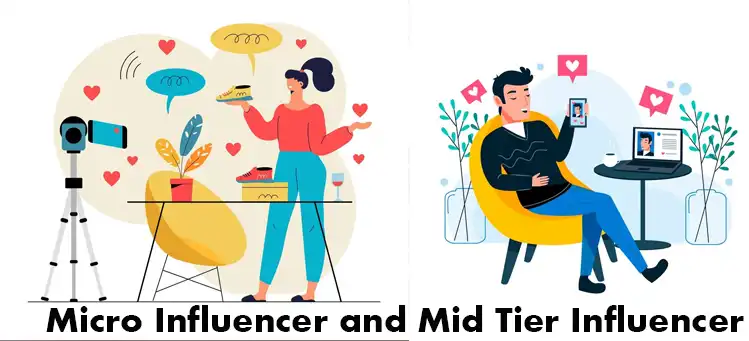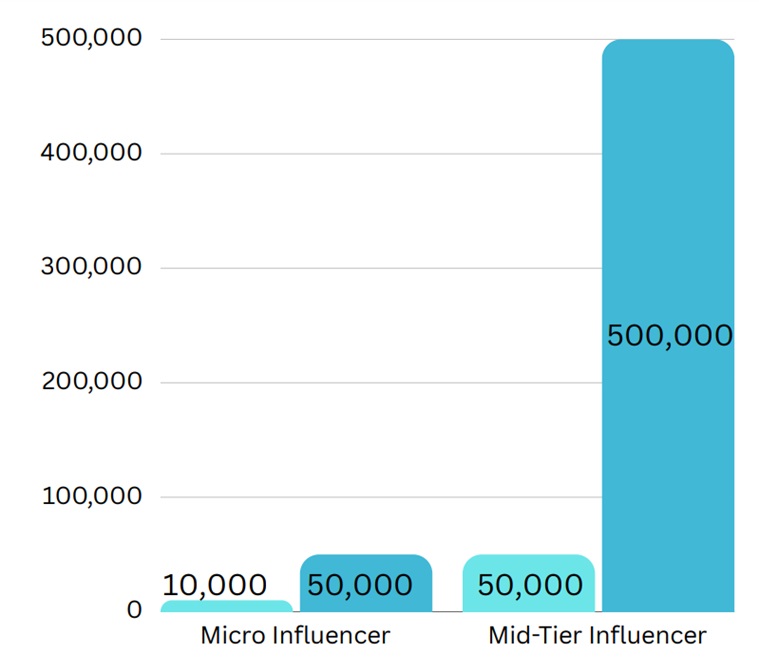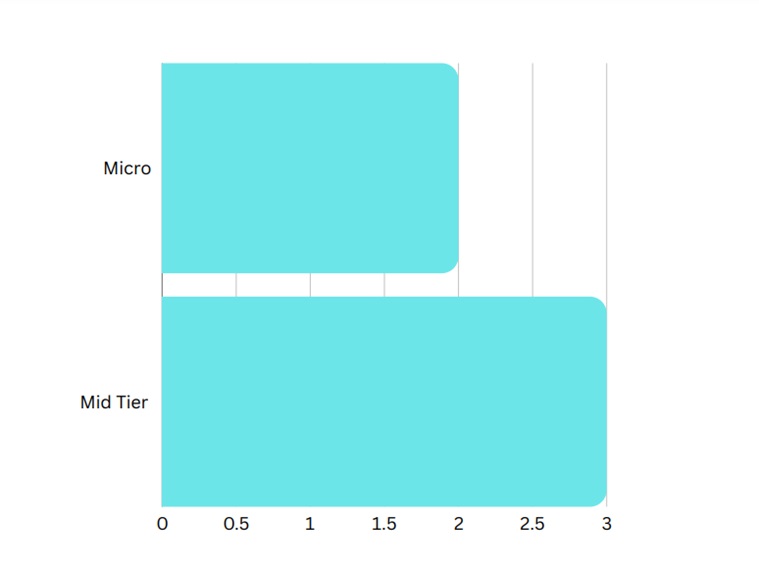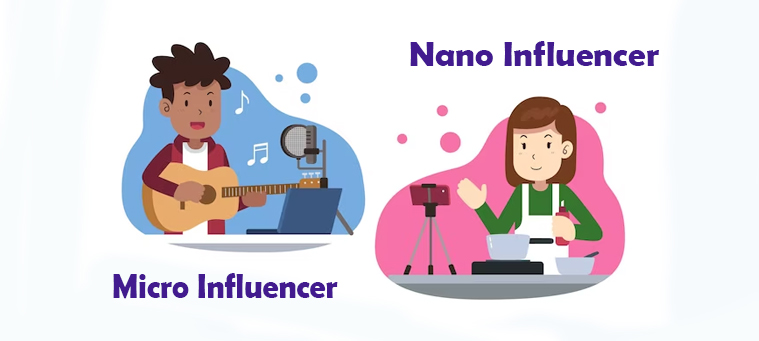In the world of social media marketing, “influencers” have become a popular way for brands to reach targeted audiences. However, not all influencers have the same reach and impact.
Two categories—micro influencers and mid-tier influencers—operate at different levels when it comes to audience size, content authenticity, compensation rates, and more.

1. Follower Count
The most basic difference between micro and mid-tier influencers lies in the number of followers they have. While there are no hard numbers that universally define these tiers, generally:
- Micro influencers follower count usually falls within the 10,000 to 50,000 range.
- Mid-tier influencers have between 50,000 to 500,000 followers.
The lower follower count allows micro influencers to foster stronger, more authentic connections with their audience. Mid-tier influencers have more reach, but engagement starts to decline as follower counts rise towards the millions.

2. Reach and Engagement
Follower count alone does not determine the value of an influencer. Reach and engagement are equally, if not more, important metrics.
- Micro influencers may have smaller follower bases, but they tend to have higher engagement rates and can drive targeted traffic. Engagement rates of 2%.
- Mid-tier influencers deliver greater overall reach and impressions. But average engagement falls 3% or above.
Higher engagement signifies an influencer’s audience is more interested in their content and responsive to recommendations. Micro influencers’ niche focus fosters loyalty and trust leading followers to act on promotions.

3. Niche and Expertise
Micro and mid-tier influencers also differ in terms of niche and expertise:
- Micro influencers occupy specific, well-defined niches like parenting, fashion, or health. Their domain expertise lends credibility and helps attract an engaged audience with shared interests.
- Mid-tier influencers usually have a broader focus with content spanning lifestyle, travel, fashion, and more. They offer less depth but wider exposure.
A micro influencer’s niche is more targeted and supports better alignment between influencer content and brand campaigns. Niche focus also indicates true passion and knowledge.
4. Content Quality and Production
Content production volume and quality is another area where micro and mid-tier influencers diverge:
- Micro influencers tend to publish less frequently but offer high-quality, original content. Photos and videos are carefully curated and crafted.
- Mid-tier influencers churn out content more consistently, sometimes publishing daily or multiple times a day. But quality suffers due to reliance on freelancers and sponsor-driven content.
Micro influencers have fewer resources but place greater emphasis on creating cohesive, authentic content true to their brand image. This resonates more with their engaged communities.
5. Cost and Availability
Finally, when it comes to compensation and availability, micro influencers have some clear advantages:
- Micro influencers are more affordable with typical fees ranging from $100 to $500 per post depending on factors like niche, engagement metrics, and existing brand partnerships. Their smaller scale also makes them more accessible.
- Mid-tier influencers are in higher demand and charge accordingly. Sponsored post fees can run from $500 to well over $5,000. Lead times tend to be longer too.
For the same budget, brands can activate multiple micro influencers instead of a single mid-tier influencer and achieve better combined reach.
Summary: Micro vs Mid Tier Influencer
| Factor | Micro Influencer | Mid-Tier Influencer |
| Follower Count | 10,000 to 50,000 | 50,000 to 500,000 |
| Engagement Rate | 2% | 3% or above |
| Niche / Expertise | Specific, well-defined niches | Broader focus, less depth |
| Content Quality and Frequency | Less frequent, high-quality, original content | More consistent, lower quality |
| Content Types | Photos, videos | More sponsor-driven |
| Cost Per Post | $100 to $500 | $500 to $5,000+ |
| Availability | More accessible | Longer lead times |
What Type of Influence is Right for Your Product?
When evaluating the optimal influencer tier for your brand, consider factors like:
Budget – Micro influencers offer high engagement at low rates, while mid-tier options command premium packages. Evaluate cost-per-conversion and expected campaign reach based on spending limits.
Branding Goals – Micro influencers drive transparent recommendations from a trusted voice. Mid-tier influencers expand awareness rapidly with polished content. Prioritize authenticity or reach accordingly.
Target Audience – Both tiers deliver targeted niche communities, but the mid-tier can push towards generalized demographics. Identify precise viewer personas and engagement levels.
Content Expectations – Micro influencers maintain creative control over partnership deliverables. Mid-tier negotiates more brand requirements but causes review delays. Define needed assets and create flexibility.
Why Mixing Multiple Influencer Types Is The Better Approach?
Wider Reach – By partnering with both tiers, you can achieve expanded brand awareness from mid-tier influencers while also driving targeted engagement through micro-influencers. The combined effort reaches more potential customers.
Complimentary Content – Micro influencer content offers authenticity and mid-tier brings professional polish. Using both provides variety and depth across media like Instagram posts, Stories, Reels, and more.
Budget Optimization – Blending both tiers allows increased overall campaign scale despite the higher rates of mid-tier influencers. Micro partnerships offset costs so more content gets created.
Creative Flexibility – More influencers participating means increased content innovation. Brands can experiment with different partnership formats across a diverse mix of creators.
Diversified Risks – Don’t put all eggs in one influencer basket. Spreading partnerships across more nano and micro influencers insulates against individual underperformance or loss of larger mid-tier accounts.
The ideal mix depends on specific campaign goals and budget, but most brands see better total engagement, clicks, and conversions from a combined micro and mid-tier influencer approach. Just allocate spending appropriately based on the strengths of each tier.
Final Thoughts
While micro and mid-tier influencers both offer benefits for social media marketing campaigns, understanding the differences helps match partnerships to brand goals. Micro influencers provide authentic promotions and high engagement at affordable rates. Mid-tier influencers expand their reach dramatically and may justify higher costs with audience size. Weighing influencer tier options based on priorities like budget, branding, or conversions ensures optimal partnerships.

